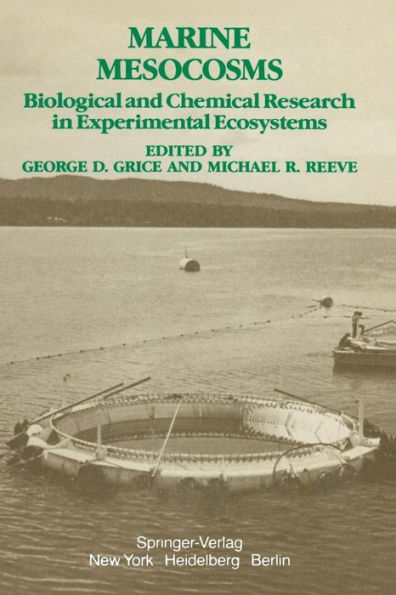5
1

Marine Mesocosms: Biological and Chemical Research in Experimental Ecosystems
430
by G.D. Grice (Editor), M.R. Reeve (Editor)
G.D. Grice

Marine Mesocosms: Biological and Chemical Research in Experimental Ecosystems
430
by G.D. Grice (Editor), M.R. Reeve (Editor)
G.D. Grice
Paperback(Softcover reprint of the original 1st ed. 1982)
$109.99
-
PICK UP IN STORECheck Availability at Nearby Stores
Available within 2 business hours
Related collections and offers
109.99
In Stock
Overview
Techniques developed for enclosing viable natural planktonic ecosystems provided the opportunity for prolonged and detailed investigation of dynamic events within the pelagic system of a known water body. Recent investigations into plankton ecology, using enclosure systems in dif ferent marine environments, are discussed in relation to the data obtained from the Nanaimo, British Columbia, Canada, plastic-sphere experiments of 1960 and 1962. Three types of modern enclosure experiments are recognized: floating systems within nutrient levels maintained or running down, and benthic attached systems. The review largely discusses results from the two kinds of floating systems. Processes at several trophic levels have been investigated in enclosures. This review attempts to draw together details from all experimental systems to emphasize the enclosures' contribution to our understanding of planktonic systems. Enclosures made it possible to examine primary production processes, particularly in relation to inorganic nutrient availability and water-column sta bility. Recent experiments have used the understanding of these processes as a management technique in maintaining different planktonic systems. Relation ships between primary and secondary trophic levels are not always easy to inter pret, since the growth of primary carnivore populations can often determine the survival of zooplankton populations. Nevertheless, the development of co horts of herbivorous zooplankton has been followed in several enclosures, yield ing useful information on development times and production rates. In enclosed systems it is thus possible to directly relate tertiary level production to inorganic nutrient input, and to calculate production rates and exchange efficiencies at several trophic levels.

Product Details
| ISBN-13: | 9781461256472 |
|---|---|
| Publisher: | Springer New York |
| Publication date: | 12/27/2011 |
| Edition description: | Softcover reprint of the original 1st ed. 1982 |
| Pages: | 430 |
| Product dimensions: | 6.10(w) x 9.25(h) x 0.04(d) |
Table of Contents
o.- 1 Introduction and Description of Experimental Ecosystems.- 2 Experimental Marine Ecosystem Enclosures in a Historical Perspective.- 3 Application of Enclosures to the Study of Marine Pelagic Systems.- 4 Application of Enclosures to Studies on the Early Life History of Fishes.- 5 Application of Enclosures to the Study of Ocean Chemistry.- 6 Radiotracers in Studies of Trace Metal Behavior in Mesocosms: Advantages and Limitations.- 7 Natural Radionuclides as Tracers for Geochemical Processes in MERL Mesocosms and Narragansett Bay.- 8 Controlled Marine Ecosystems-A Tool for Studying Stable Trace Metal Cycles: Long-Term Response and Variability.- 9 Fate of Radiolabeled Polycyclic Aromatic Hydrocarbons and Pentachlorophenol in Enclosed Marine Ecosystems.- 10 Biogeochemistry of Volatile Organic Compounds in Marine Experimental Ecosystems and the Estuarine Environment-Initial Results.- 11 The Use of Experimental Ecosystems for Evaluating the Environmental Impact of Pollutants: A Comparison of an Oil Spill in the Baltic Sea and Two Long-Term, Low-Level Oil Addition Experiments in Mesocosms.- 12 Processes Affecting the Movement and Speciation of Mercury in the Marine Environment.- 13 Ecotoxicological Experiments with Marine Plankton Communities in Plastic Bags.- 14 Plankton Spring Development in a South Norwegian Fjord.- 15 The Plankton Tower. IV. Interactions Between Water Column and Sediment in Enclosure Experiments in Kiel Bight Victor Smetacek, Bodo von Bodungen, Bastiaan Knoppers,.- 16 Replication in Controlled Marine Systems: Presenting the Evidence.- 17 Predator Control in Enclosures.- 18 Food and Growth of Juvenile Herring, Clupea harengus pallasi, in CEPEX Enclosures.- 19 Sedimentation of Phytoplankton Cells Within Controlled Experimental Ecosystems Following Launching, and Implications for Further Enclosure Studies.- 20 Phytoplankton Sinking-Rate Dynamics in Enclosed Experimental Ecosystems.- 21 The Manipulation of Physical, Chemical, and Biological Factors to Select Species from Natural Phytoplankton Communities.- 22 The Use of Enclosed Experimental Ecosystems to Study Nitrogen Dynamics in Coastal Waters.- 23 Microbial Contribution to Overall Plankton Community Respiration-Studies in Enclosures.- 24 The Importance of Understanding Phytoplankton Life Strategies in the Design of Enclosure Experiments.- 25 Phytoplankton Species' Responses to Nutrient Changes in Experimental Enclosures and Coastal Waters.- 26 The Population Biology of the Larvacean Oikopleura dioica in Enclosed Water Columns.- 27 Trophic Interactions and Production Processes in Natural Zooplankton Communities in Enclosed Water Columns.- 28 The CEPEX Approach and Its Implications for Future Studies in Plankton Ecology.- 29 How Can Enclosing Seawater Liberate Biological Oceanographers?.- 30 The Future of Controlled Ecosystem Enclosure Experiments.From the B&N Reads Blog
Page 1 of
